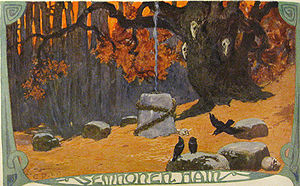
Grove of fetters
Encyclopedia

Poetic Edda
The Poetic Edda is a collection of Old Norse poems primarily preserved in the Icelandic mediaeval manuscript Codex Regius. Along with Snorri Sturluson's Prose Edda, the Poetic Edda is the most important extant source on Norse mythology and Germanic heroic legends, and from the early 19th century...
Helgakviða Hundingsbana II
Helgakviða Hundingsbana II
Völsungakviða in forna, Helgakviða Hundingsbana II or the Second Lay of Helgi Hundingsbane is an Old Norse poem found in the Poetic Edda...
:
- Helgi obtained Sigrún
SigrúnSigrún is a valkyrie in Norse mythology. Her story is related in Helgakviða Hundingsbana I and Helgakviða Hundingsbana II, in the Poetic Edda...
, and they had sons. Helgi lived not to be old. Dag, the son of Högni, sacrificed to OdinOdinOdin is a major god in Norse mythology and the ruler of Asgard. Homologous with the Anglo-Saxon "Wōden" and the Old High German "Wotan", the name is descended from Proto-Germanic "*Wodanaz" or "*Wōđanaz"....
, for vengeance for his father. Odin lent Dag his spear. Dag met with his relation Helgi in a place called Fiöturlund, and pierced him through with his spear. Helgi fell there, but Dag rode to the mountains and told Sigrún what had taken place.- ― Helgakviða Hundingsbana II, Thorpe's translation
The description is often compared with a section by Tacitus
Tacitus
Publius Cornelius Tacitus was a senator and a historian of the Roman Empire. The surviving portions of his two major works—the Annals and the Histories—examine the reigns of the Roman Emperors Tiberius, Claudius, Nero and those who reigned in the Year of the Four Emperors...
on a sacred grove
Sacred grove
A sacred grove is a grove of trees of special religious importance to a particular culture. Sacred groves were most prominent in the Ancient Near East and prehistoric Europe, but feature in various cultures throughout the world...
of the Semnones:
- At a stated period, all the tribes of the same race assemble by their representatives in a grove consecrated by the auguries of their forefathers, and by immemorial associations of terror. Here, having publicly slaughtered a human victim, they celebrate the horrible beginning of their barbarous rite. Reverence also in other ways is paid to the grove. No one enters it except bound with a chain, as an inferior acknowledging the might of the local divinity. If he chance to fall, it is not lawful for him to be lifted up, or to rise to his feet; he must crawl out along the ground. All this superstition implies the belief that from this spot the nation took its origin, that here dwells the supreme and all-ruling deity
Regnator omnium deusIn Tacitus' work Germania from the year 98, regnator omnium deus was a deity worshipped by the Semnones tribe in a sacred grove...
, to whom all else is subject and obedient.
Due to the resemblance between the two texts some scholars have identified the deity of the Semnones with an early form of Odin
Wodanaz
or is the reconstructed Proto-Germanic name of a god of Germanic paganism, known as in Norse mythology, in Old English, or in Old High German and in Lombardic...
. Others suggest an early form of Týr may have been involved as he is the one to put fetters on Fenrir in Norse mythology
Norse mythology
Norse mythology, a subset of Germanic mythology, is the overall term for the myths, legends and beliefs about supernatural beings of Norse pagans. It flourished prior to the Christianization of Scandinavia, during the Early Middle Ages, and passed into Nordic folklore, with some aspects surviving...
. There is insufficient evidence for a certain identification.
Further reading
The following works are listed in Rudolf Simek's Dictionary.- O. Höfler (1952). "Das Opfer im Semnonenhain und die Edda" (Edda, Skalden, Saga. Festschrift F. Genzmer) Heidelberg.
- R. W. Fischer (1963). "Vinculo ligatus" (Antaios 5).
- R. Much (1967). Die Germania des Tacitus. Heidelberg.
- J. de Vries (1970). Altgermanische Religiongeschichte. Berlin.

